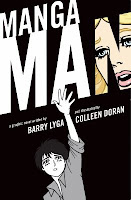Support manga, support your library!
Here’s what I’ve been reading:
 Black Blizzard by Yoshihiro Tatsumi. When a train is derailed by an avalanche, two criminals on board make their escape. Handcuffed together, they disappear into the mountains under the cover of a blizzard. Black Blizzard was my introduction to Tatsumi. It also happens to be Tatsumi’s first full length, non-serialized graphic novel. Written in the late 1950s, it is one of the earliest examples of gekiga. Black Blizzard is a great read, even if the ending’s twist seems a little too convenient. But even so, the story is quickly paced and engaging. The English-language edition of Black Blizzard from Drawn and Quarterly also includes an interview with Tatsumi which is a nice addition.
Black Blizzard by Yoshihiro Tatsumi. When a train is derailed by an avalanche, two criminals on board make their escape. Handcuffed together, they disappear into the mountains under the cover of a blizzard. Black Blizzard was my introduction to Tatsumi. It also happens to be Tatsumi’s first full length, non-serialized graphic novel. Written in the late 1950s, it is one of the earliest examples of gekiga. Black Blizzard is a great read, even if the ending’s twist seems a little too convenient. But even so, the story is quickly paced and engaging. The English-language edition of Black Blizzard from Drawn and Quarterly also includes an interview with Tatsumi which is a nice addition.
 Here Is Greenwood, Volumes 1-2 by Yukie Nasu. Okay, I’m really enjoying this one. Here Is Greenwood isn’t an outstanding series, but for the right audience (to which I apparently belong) it’s solidly entertaining. It has a large cast of quirky and offbeat characters. The residents of the “Greenwood” dormitory frequently find themselves in some fairly ridiculous and unbelievable situations, generally of their own creation. The main protagonist is Kazuya Hasukawa, a perpetually stressed out student at the prestigious all-boys Ryokuto Academy who Mitsuru Ikeda, the head resident of the dormitory, delights in tormenting. Here Is Greenwood is really funny stuff if you enjoy the absurd, which I certainly do.
Here Is Greenwood, Volumes 1-2 by Yukie Nasu. Okay, I’m really enjoying this one. Here Is Greenwood isn’t an outstanding series, but for the right audience (to which I apparently belong) it’s solidly entertaining. It has a large cast of quirky and offbeat characters. The residents of the “Greenwood” dormitory frequently find themselves in some fairly ridiculous and unbelievable situations, generally of their own creation. The main protagonist is Kazuya Hasukawa, a perpetually stressed out student at the prestigious all-boys Ryokuto Academy who Mitsuru Ikeda, the head resident of the dormitory, delights in tormenting. Here Is Greenwood is really funny stuff if you enjoy the absurd, which I certainly do.
 Nana, Volumes 1-4 by Ai Yazawa. The first volume of Nana serves as a sort of prologue to the main series and can stand completely on its own. It introduces the two main characters and their backstories: Nana Komatsu, a young woman trying to establish her independence after one too many heartbreaks, and Nana Osaki, a punk singer working towards her success as a musician. The two women become roommates by chance more than anything else, but their friendship becomes very important to them. The characterization in Nana is phenomenal. All of the characters are complex and their relationships are complicated and messy. Nana has a sense of humor, but it’s really the human drama that makes the series.
Nana, Volumes 1-4 by Ai Yazawa. The first volume of Nana serves as a sort of prologue to the main series and can stand completely on its own. It introduces the two main characters and their backstories: Nana Komatsu, a young woman trying to establish her independence after one too many heartbreaks, and Nana Osaki, a punk singer working towards her success as a musician. The two women become roommates by chance more than anything else, but their friendship becomes very important to them. The characterization in Nana is phenomenal. All of the characters are complex and their relationships are complicated and messy. Nana has a sense of humor, but it’s really the human drama that makes the series.
 Peace Maker Kurogane, Volumes 1-3 by Nanae Chrono. I’ve enjoyed manga with a basis in history for quite some time. More recently, I’ve developed a particular interest in the Shinsengumi. So, I was looking forward to giving Peace Maker Kurogane a try. Unfortunately, these early volumes just aren’t working for me. I have a decent handle on what was happening during the time period in which the series takes place, but I had a hard time following the plot of the story or even caring about what was going on. Things start to come together and get to be more interesting with the third volume, but I’m not sure that’ll be enough for me to track down the rest of the volumes that are available in English.
Peace Maker Kurogane, Volumes 1-3 by Nanae Chrono. I’ve enjoyed manga with a basis in history for quite some time. More recently, I’ve developed a particular interest in the Shinsengumi. So, I was looking forward to giving Peace Maker Kurogane a try. Unfortunately, these early volumes just aren’t working for me. I have a decent handle on what was happening during the time period in which the series takes place, but I had a hard time following the plot of the story or even caring about what was going on. Things start to come together and get to be more interesting with the third volume, but I’m not sure that’ll be enough for me to track down the rest of the volumes that are available in English.




